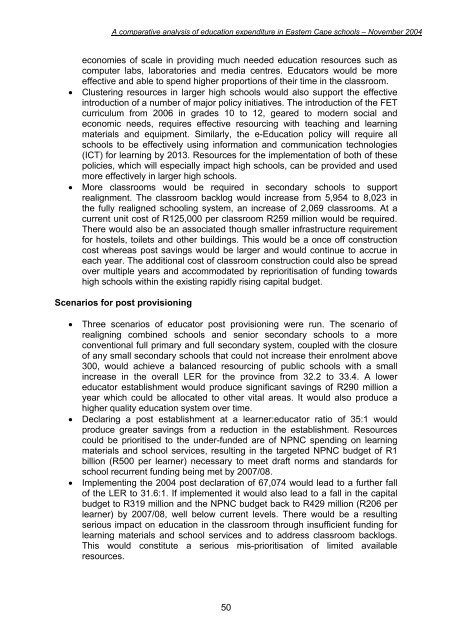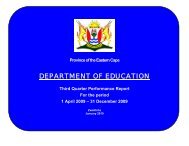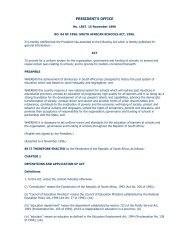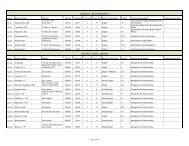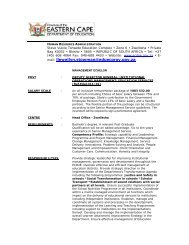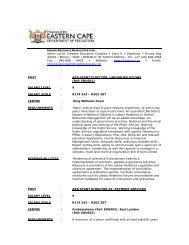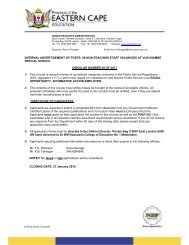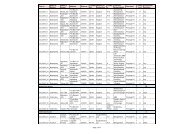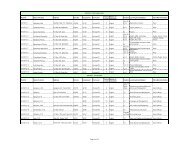School Community Integration Pilot Project - Department of Education
School Community Integration Pilot Project - Department of Education
School Community Integration Pilot Project - Department of Education
Create successful ePaper yourself
Turn your PDF publications into a flip-book with our unique Google optimized e-Paper software.
A comparative analysis <strong>of</strong> education expenditure in Eastern Cape schools – November 2004<br />
economies <strong>of</strong> scale in providing much needed education resources such as<br />
computer labs, laboratories and media centres. Educators would be more<br />
effective and able to spend higher proportions <strong>of</strong> their time in the classroom.<br />
• Clustering resources in larger high schools would also support the effective<br />
introduction <strong>of</strong> a number <strong>of</strong> major policy initiatives. The introduction <strong>of</strong> the FET<br />
curriculum from 2006 in grades 10 to 12, geared to modern social and<br />
economic needs, requires effective resourcing with teaching and learning<br />
materials and equipment. Similarly, the e-<strong>Education</strong> policy will require all<br />
schools to be effectively using information and communication technologies<br />
(ICT) for learning by 2013. Resources for the implementation <strong>of</strong> both <strong>of</strong> these<br />
policies, which will especially impact high schools, can be provided and used<br />
more effectively in larger high schools.<br />
• More classrooms would be required in secondary schools to support<br />
realignment. The classroom backlog would increase from 5,954 to 8,023 in<br />
the fully realigned schooling system, an increase <strong>of</strong> 2,069 classrooms. At a<br />
current unit cost <strong>of</strong> R125,000 per classroom R259 million would be required.<br />
There would also be an associated though smaller infrastructure requirement<br />
for hostels, toilets and other buildings. This would be a once <strong>of</strong>f construction<br />
cost whereas post savings would be larger and would continue to accrue in<br />
each year. The additional cost <strong>of</strong> classroom construction could also be spread<br />
over multiple years and accommodated by reprioritisation <strong>of</strong> funding towards<br />
high schools within the existing rapidly rising capital budget.<br />
Scenarios for post provisioning<br />
• Three scenarios <strong>of</strong> educator post provisioning were run. The scenario <strong>of</strong><br />
realigning combined schools and senior secondary schools to a more<br />
conventional full primary and full secondary system, coupled with the closure<br />
<strong>of</strong> any small secondary schools that could not increase their enrolment above<br />
300, would achieve a balanced resourcing <strong>of</strong> public schools with a small<br />
increase in the overall LER for the province from 32.2 to 33.4. A lower<br />
educator establishment would produce significant savings <strong>of</strong> R290 million a<br />
year which could be allocated to other vital areas. It would also produce a<br />
higher quality education system over time.<br />
• Declaring a post establishment at a learner:educator ratio <strong>of</strong> 35:1 would<br />
produce greater savings from a reduction in the establishment. Resources<br />
could be prioritised to the under-funded are <strong>of</strong> NPNC spending on learning<br />
materials and school services, resulting in the targeted NPNC budget <strong>of</strong> R1<br />
billion (R500 per learner) necessary to meet draft norms and standards for<br />
school recurrent funding being met by 2007/08.<br />
• Implementing the 2004 post declaration <strong>of</strong> 67,074 would lead to a further fall<br />
<strong>of</strong> the LER to 31.6:1. If implemented it would also lead to a fall in the capital<br />
budget to R319 million and the NPNC budget back to R429 million (R206 per<br />
learner) by 2007/08, well below current levels. There would be a resulting<br />
serious impact on education in the classroom through insufficient funding for<br />
learning materials and school services and to address classroom backlogs.<br />
This would constitute a serious mis-prioritisation <strong>of</strong> limited available<br />
resources.<br />
50


